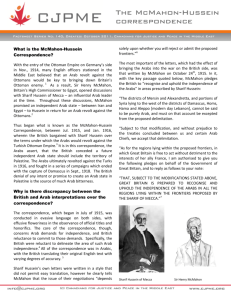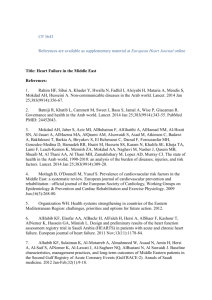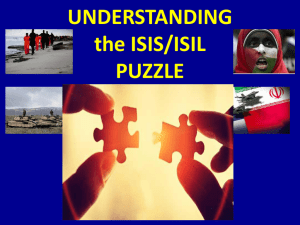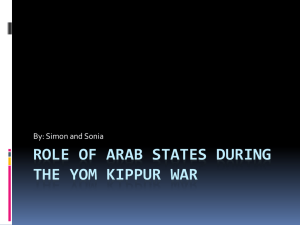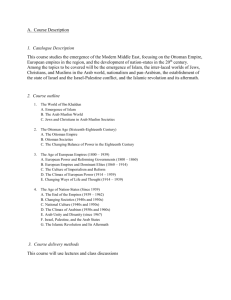Untitled - The Cairo Review of Global Affairs
advertisement
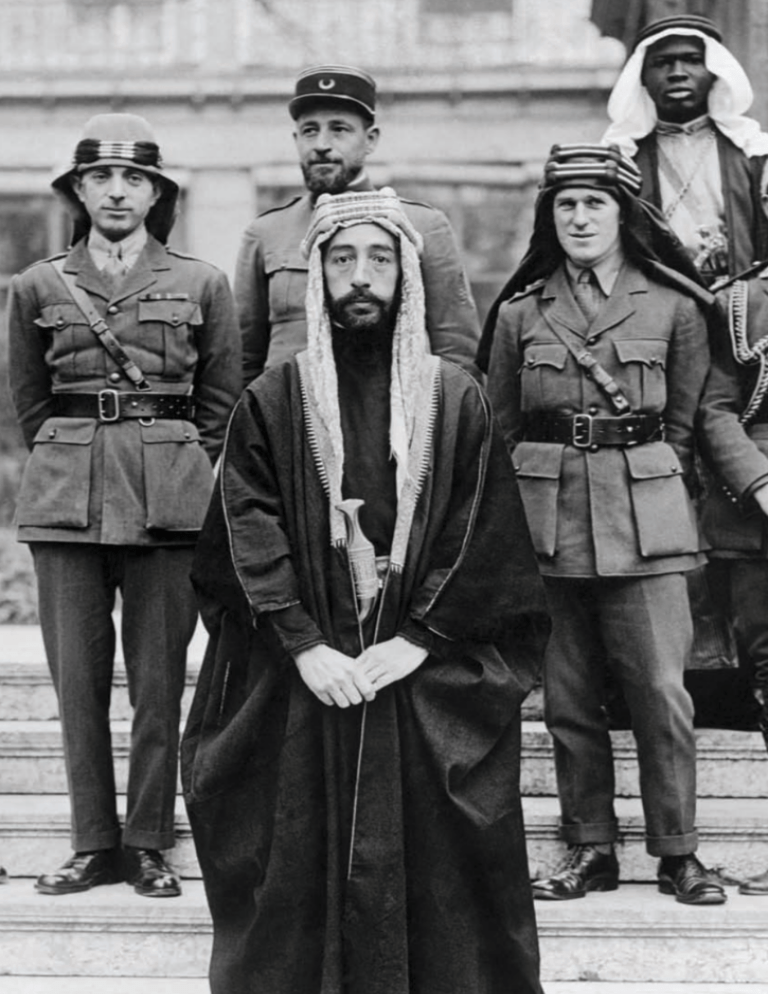
A Century After Sykes-Picot The Fall of the Ottomans, the Rise of the Islamic State, and the Tragedy of Arab Independence By Eugene Rogan T he British wartime alliance with the sharif of Mecca would be concluded after months of increasingly anxious negotiations, with both sides driven by wartime fears. Sharif Hussein had reason to believe the Young Turks sought his overthrow. Moreover, to realize his ambitious goal of carving an independent Arab kingdom from Ottoman domains, he needed Great Power support. The British feared their recent string of defeats to the Ottomans would encourage colonial Muslims to rebel against the Entente Powers. War planners in Cairo and Whitehall hoped that an alliance with the custodian of Islam’s holiest shrines would neutralize the appeal of the Ottoman sultan-caliph’s jihad at a moment when Britain’s military credibility was at its lowest point since the start of the war. On the eve of the Arab Revolt, the Anglo-Hashemite alliance offered far less than both sides originally believed they were securing on first entering into negotiations. The British were not the invincible power they had appeared to be in early 1915 when first setting off to conquer Constantinople. The Germans had inflicted terrible casualties on the British on the western front, and even the Ottomans had dealt them humiliating defeats. Sharif Hussein and his sons had every reason to question their choice of ally. Yet the Hashemites were in no position to bargain. All through their correspondence with Sir Henry McMahon, the high commissioner in Egypt, Sharif Hussein and his sons had presented themselves as leaders of a pan-Arab movement. By May 1916 it was apparent that there would be no broader revolt in Syria and Iraq. The most the sharifs could do was challenge Ottoman rule in the Hijaz. Success depended on their ability to mobilize the notoriously undisciplined Bedouin to their cause. Arguably, the alliance survived because the Hashemites and the British needed each v Emir Faisal and entourage at the other more in the summer of 1916 than ever. Paris Peace Conference, Versailles, Sharif Hussein had strained relations with the 1919. Bettmann/Corbis CAI RO RE VI E W 1 9 /2 0 1 5 99 EU G ENE ROGAN Young Turks to the breaking point; he knew they would seize the first opportunity to dismiss—even murder—him and his sons. The British needed the sharif’s religious authority to undermine the Ottoman jihad, which officials in Cairo and Whitehall feared recent Turkish victories had strengthened. Whatever the results of a Hashemite-led revolt, the movement would at least weaken the Ottoman war effort and force the Turks to divert troops and resources to restore order in the Hijaz and possibly in other Arab provinces. For their own reasons, both the British and the Hashemites were in a hurry to launch the revolt. It fell to Sharif Hussein to fire the opening shot of the Arab Revolt from his palace in the holy city of Mecca. On June 10, 1916, the emir of Mecca took up a rifle and fired once at the Ottoman barracks to initiate the uprising. The Hashemites were at war with the Turks in the name of the Arab peoples. British and French war planners came to view the Arab Revolt as a distinct asset in the Great War. As early as July 1916, the War Committee had based new strategic objectives for its forces in Egypt on the strength of early Hashemite gains in the Hijaz. The committee instructed the commander in chief in Egypt, Lieutenant General Sir Archibald Murray, to establish British control along a line extending across northern Sinai from El-Arish on the Mediterranean to the tiny port of Aqaba on the eastern head of the Red Sea. British war planners maintained that these measures would “threaten communications between Syria and the Hijaz, and encourage Syrian Arabs” in support of the Arab Revolt. So began the fateful link between the Hashemite revolt in Arabia and the British campaign in Palestine that, between them, would ultimately spell the downfall of the Ottoman Empire. “A Shocking Document” In correspondence exchanged between November 5, 1915 and March 10, 1916, Sir Henry McMahon concluded the alliance with Sharif Hussein. The weeks that passed between their letters were punctuated by British defeats in both the Dardanelles and Mesopotamia. McMahon’s letter of December 14 followed both the British cabinet’s decision to evacuate the Suvla and Anzac positions in Gallipoli (December 7) and the beginning of the siege of Kut Al-Amara (December 8). The high commissioner’s letter of January 25, 1916 followed the final evacuation of Gallipoli (January 9). Unsurprisingly, McMahon’s last letter, dated March 10, noted British victories over the Sanussi tribesmen in Egypt and Russian victories in Erzurum without mentioning the impending surrender at Kut. He must have felt his hand weakened by this string of British defeats. Knowing that he was negotiating with a beleaguered Britain, Sharif Hussein drove a hard bargain. Instead of seeking recognition of Arab independence, the emir increasingly wrote of an “Arab kingdom” and of himself as its chosen leader. Yet the emir of Mecca 100 CAI RO RE VI E W 1 9 /2 0 1 5 A C E N T U RY A F T E R SY K E S - PI COT consented to significant territorial compromises. He claimed “the Iraqi wilayets” as integral parts of the future Arab kingdom but consented to leave “those districts now occupied by the British troops” under British administration for “a short time” in return for “a suitable sum paid as compensation to the Arab kingdom for the period of occupation.” French claims to Syria were harder for the emir to accept. The Syrian provinces, he insisted, were “purely Arab” and could not be excluded from the Arab kingdom. Yet in the course of their exchange, Sharif Hussein conceded he wished “to avoid what may possibly injure the alliance of Great Britain and France and the agreement made between them during the present wars and calamities.” However, he warned McMahon, “at the first opportunity after this war is finished . . . we shall ask you for what we now leave to France in Beirut and its coasts.” The remainder of the correspondence focused on the material needs for a revolt: the gold, grain, and guns to sustain the future Arab war effort against the Turks. Sir Henry McMahon could not have done better. He succeeded in concluding an agreement with the sharif of Mecca excluding Syrian territory claimed by the French and the Iraqi provinces the British wished to retain. The fact that the boundaries of the territories conceded in the Hussein–McMahon Correspondence were vague was an advantage in wartime Anglo-Arab relations. In the interest of Anglo-French relations, though, a more precise agreement on the postwar partition of Arab lands was needed. The British government was bound to seek French agreement on promises made to Sharif Hussein. The foreign secretary, Sir Edward Grey, had previously recognized France’s special interest in Syria. In October 1915, after authorizing McMahon’s territorial concessions to Sharif Hussein, the Foreign Office requested that the French government send negotiators to London to put some clearly defined boundaries to French claims in Syria. The French foreign minister designated the former consul general in Beirut, Charles François Georges-Picot, to negotiate with Sir Mark Sykes, Lord Kitchener’s Middle East advisor, in drafting a mutually acceptable postwar partition of Arab lands. The fact that the British and French were dividing amongst themselves lands that Sharif Hussein was claiming for the future Arab kingdom has led many historians to denounce the Sykes-Picot Agreement as an outrageous example of imperial perfidy— none more eloquently than Palestinian historian George Antonius: “The Sykes-Picot Agreement is a shocking document. It is not only the product of greed at its worst, that is to say, of greed allied to suspicion and so leading to stupidity: it also stands out as a startling piece of double-dealing.” Yet for Britain and France, whose past imperial rivalries had nearly led them to war, the Sykes-Picot Agreement was an essential exercise for France to define precisely the territories it claimed in Cilicia and Syria and for Britain to stake its claim in Mesopotamia—the lands Sir Henry McMahon tried to exclude from his pledge to Sharif Hussein. CAI RO RE VI E W 1 9 /2 0 1 5 101 EU G ENE ROGAN There are many misconceptions about the Sykes-Picot Agreement. A century later, many still believe the agreement set the borders of the modern Middle East. In fact, the map as drawn by Sykes and Picot bears no resemblance to the Middle East today. Instead, it defined areas of colonial domination in Syria and Mesopotamia in which France and Britain were free “to establish such direct or indirect administration or control as they desire[d].” In the “blue area,” France laid claim to the eastern Mediterranean coastline stretching from Mersin and Adana, around the Gulf of Alexandretta and southward through the shores of modern Syria and Lebanon to the ancient port town of Tyre. The French also claimed an extensive part of eastern Anatolia to a point north of Sivas and to the east of Diyarbakır and Mardin—all towns comfortably inside the modern Turkish Republic. In the “red areas,” the British secured recognition of their claim to the Iraqi provinces of Basra and Baghdad. The vast lands between the blue and red areas were divided into separate zones in which Britain and France would exercise informal influence. Zone A placed the major inland cities of Syria—Aleppo, Homs, Hama, and Damascus, as well as the northern Iraqi city of Mosul—under indirect French control. The British claimed informal empire over Zone B, which spanned the deserts of northern Arabia from Iraq to the Sinai frontiers of Egypt. These two zones were to be part of “an independent Arab State or a Confederation of Arab States . . . under the suzerainty of an Arab chief”—a formula that fell well short of Sir Henry McMahon’s pledges to Sharif Hussein. The one area on which the British and French could not agree was Palestine. They could not resolve their conflicting claims and anticipated that Russian ambitions would further complicate negotiations. Sykes and Picot decided to paint the map of Palestine brown, to distinguish it from the red and blue areas, and proposed an “international administration” whose ultimate shape would only be decided in negotiations with Russia, the “other Allies, and the representatives of the Shereef of Mecca”—the only explicit mention of Sharif Hussein in the Sykes-Picot Agreement. In March 1916, Sykes and Picot traveled to Russia to secure their Entente ally’s agreement to their partition plan. In addition to their earlier claims to the straits and Constantinople, confirmed in the 1915 Constantinople Agreement, the tsar’s ministers sought British and French recognition of the annexation of the Turkish territories that the Russian army had recently overrun—Erzurum, the Black Sea port of Trabzon, the shattered city of Van, and Bitlis—as the price for their acquiescence to the terms of Sykes-Picot. With Russia’s support secured by May 1916, the Allies had achieved a comprehensive agreement on the postwar partition of the Ottoman Empire. And for the moment, they managed to keep the whole matter secret from their Arab allies, Sharif Hussein and his sons. 102 CAI RO RE VI E W 1 9 /2 0 1 5 A C E N T U RY A F T E R SY K E S - PI COT The twelfth of Woodrow Wilson’s Fourteen Points assured the Arabs, along with the other subject peoples of the Ottoman Empire, “an undoubted security of life and an absolutely unmolested opportunity of autonomous development.” Political activists were at work in Syria and Mesopotamia debating different political visions, freed from the constraints imposed by decades of Ottoman political repression. In Egypt, political elites knew precisely what they wanted. After thirty-six years of British occupation, they wanted Egypt’s total independence. A group of prominent Egyptian politicians approached the British authorities in Cairo to request permission to present their case for independence at the Paris Peace Conference. Sir Reginald Wingate, British high commissioner, received the delegation led by veteran politician Saad Zaghloul two days after the armistice with Germany, on November 13, 1918. He heard the delegates out and promptly declined their request to attend the peace conference in no uncertain terms. The Paris Peace Conference was to decide the fate of the defeated powers and in no way concerned Egypt. When Zaghloul and his colleagues persisted in their efforts, they were arrested on March 8, 1919 and deported to Malta. The following day, Egypt exploded in demonstrations that rapidly spread nationwide and across the different social classes in a common demand for independence. Egyptians in town and countryside attacked every visible manifestation of British imperial power. The railways and telegraph lines were sabotaged, government offices burned, and government centers confronted with huge crowds of protesters. The British dispatched soldiers to restore order, but soldiers are blunt tools for crowd control, and casualties began to mount. The Egyptians accused British soldiers of atrocities— of using live fire against demonstrators, burning villages, and even committing rape. By the end of March, eight hundred Egyptian civilians had been killed and a further sixteen hundred injured in the violence. To restore the calm, the British allowed Zaghloul to return to Egypt and lead a delegation to Paris in April 1919. Before the Egyptian delegation reached Paris, British Prime Minister David Lloyd George had persuaded his French and American allies that Egypt was an “imperial and not an international question.” The day the Egyptian delegation reached Paris, President Wilson recognized Britain’s protectorate over Egypt. The delegation was never granted a formal hearing by the peace conference. The war might have ended, but British rule in Egypt had not. No Peace After the war’s end, Emir Faisal presented his case for Arab independence to the Supreme Council of the Paris Peace Conference in January 1919. In light of the extensive territory Sir Henry McMahon had promised Sharif Hussein in their famous correCAI RO RE VI E W 1 9 /2 0 1 5 103 EU G ENE ROGAN spondence, Faisal’s position was very moderate. He sought immediate and full independence for Arab kingdoms in Greater Syria (corresponding to the territory of the modern states of Syria, Lebanon, Jordan, Israel, and the Palestinian Authority) and the Hijaz, then ruled by his father, King Hussein. He accepted foreign mediation in Palestine to resolve conflicting Arab and Zionist aspirations. And he acknowledged British claims to Mesopotamia, while expressing his belief that these territories would eventually join the independent Arab state he hoped to persuade the peacemakers to create. While accepting less than the Hashemites believed their British allies had promised, Faisal demanded more than the British could deliver. Prime Minister David Lloyd George needed French consent to secure British claims to Mesopotamia and Palestine. And from the very outset of the war, France had named Syria as its price. Unable to reconcile these rival claims, Britain backed its essential ally, France, and left Faisal to fend for himself. On November 1, 1919, the British withdrew their army from Syria and handed the country over to French military rule. The Syrian General Congress, an elected body convened by Faisal’s supporters with representatives from the different regions of Greater Syria, responded on March 8, 1920 by declaring the independence of Syria with Faisal as their king. But Faisal’s Syrian kingdom was not to survive. The French dispatched a colonial army from Lebanon to take control of Damascus. Encountering the remnants of Faisal’s Arab army in a mountain pass on the road between Beirut and Damascus, the French easily defeated the token force of 2,000 defenders at Khan Maysalun on July 24, 1920 and advanced into Damascus unopposed to overturn Faisal’s short-lived Syrian kingdom. Faisal carried the dashed hopes of the Arab Revolt into exile with him. The fall of Faisal’s government in Damascus left the Palestinians to face the British occupation—and the Balfour Declaration—on their own. Notables from Palestinian towns and cities had played a key role in the Syrian General Congress, and the townsmen and villagers they represented made their views known to the American commission of inquiry sent in the summer of 1919 by the Paris Peace Conference. Between June 10 and July 21, the King-Crane Commission traveled across Greater Syria to gather evidence and assess public opinion about the region’s political future. It was clear that a strong majority of Palestinian Arabs wished to be ruled as part of Faisal’s Arab kingdom. Moreover, the King-Crane Commission reported that the Palestinian Arab population was “emphatically against the entire Zionist program” and that “there was no one thing upon which the population of Palestine were more agreed than upon this.” Tensions ran high in 1920 as Jewish immigration, encouraged by the Balfour Declaration, accelerated. Between 1919 and 1921, over 18,500 Zionist immigrants flocked 104 CAI RO RE VI E W 1 9 /2 0 1 5 A C E N T U RY A F T E R SY K E S - PI COT to Palestine’s shores. Rioting broke out in Jerusalem in the first week of April 1920, leaving five Jews and four Arabs dead and over two hundred people injured. Worse violence followed in 1921, when Arab townsmen intervened in a fight between Jewish communists and Zionists in the port of Jaffa during May Day parades. In the ensuing riots, forty-seven Jews and forty-eight Arabs were killed, and over two hundred people were injured. The contradictions raised by the Balfour Declaration—in its declaration of intent to create a national home for the Jews that would not adversely affect the rights and interests of the indigenous non-Jewish population—were already apparent. The political elites in Iraq watched events in Egypt and Syria with mounting concern for their own future. They had been reassured in November 1918 when the British and French issued a declaration pledging their support for “the establishment of national governments and administrations” in the Arab lands through a process of self-determination. But the Iraqis grew increasingly suspicious as the months passed without any tangible progress toward the promised self-government. News in April 1920 that the Great Powers had agreed in San Remo to award their country to Britain as a mandate confirmed the Iraqis’ worst fears. At the end of June 1920, Iraq erupted in nationwide rebellion against British rule. Disciplined and well-organized, the insurgency threatened the British in Basra, Baghdad, and Mosul, but the center of operations lay in the same Shiite shrine towns of the Middle Euphrates that had risen against the Ottomans during the Great War. As the uprising spread, the British were forced to move additional troops into Mesopotamia to suppress determined Iraqi resistance on all fronts. Reinforcements from India were rushed to bolster the sixty thousand troops yet to be demobilized from the Mesopotamia campaign, raising British forces to over one hundred thousand by October. Using aerial bombardment and heavy artillery, the British re-conquered the Middle Euphrates region with scorched-earth tactics that crushed the resistance. “In recent days there has been bloodshed and the destruction of populous towns and the violation of the sanctity of places of worship to make humanity weep,” one journalist in Najaf wrote in October 1920. By the time the uprising was crushed at the end of October, the British claimed that 2,200 of their own forces and an estimated 8,450 Iraqis had been killed or wounded. Sharif Hussein, now king of Hijaz, followed events in Syria, Palestine, and Iraq with a deepening sense of betrayal. He had copies of every letter exchanged with Sir Henry McMahon and felt the British had broken every promise they contained. Having aspired to be king of the Arabs, Hussein was now confined to the Hijaz—and he wasn’t even secure there. A rival monarchy in central Arabia, led by Abdulaziz AlSaud, better known in the West as Ibn Saud, threatened to overrun the Hijaz. To add insult to injury, Ibn Saud enjoyed a treaty with Great Britain and received a generous monthly stipend from the British treasury. CAI RO RE VI E W 1 9 /2 0 1 5 105 EUGENE ROGAN The British too were concerned about the future of the Hijaz. While they had secured a formal treaty with Ibn Saud back in 1915, their relations with the Hashemites had been concluded in the form of a wartime alliance. Once the war was at an end, so too was the alliance. Unless the old king of the Hijaz concluded a treaty with Britain, Whitehall would have no legal basis to protect his territory. But to get King Hussein to sign a treaty, they had to get him to accept the postwar settlement hammered out at San Remo. In the summer of 1921, T.E. Lawrence was given the impossible mission of negotiating the terms of an Anglo-Hijazi treaty with the embittered King Hussein. By the time Lawrence met with King Hussein, Britain had gone some way toward redeeming Sir Henry McMahon’s broken promises. Winston Churchill, now secretary of state for the colonies, had convened a secret meeting in Cairo in March 1921 to determine the political future of Britain’s new Middle Eastern mandates. At that meeting, the British dignitaries agreed to install King Hussein’s son Faisal as king of Iraq and Abdullah as ruler of the as yet undefined territory of Transjordan (which was formally separated from Palestine in 1923). With Hashemite rulers slated for all of Britain’s mandates bar Palestine, Churchill could claim to have worked within the spirit, if not the exact lettering, of McMahon’s wartime undertakings. Between July and September 1921, Lawrence sought in vain the formula for reconciling King Hussein with Britain’s postwar position in the Middle East. Hussein refused to confine his own ambitions to the Hijaz. He objected to the separation of Syria and Lebanon from the rest of the Arab lands and their placement under French mandate. He rejected the British mandates in Iraq and Transjordan, even if they were to be nominally ruled by his sons. And he refused to sanction the pledge to establish a Jewish national home in Palestine. As King Hussein could accept nothing in the British postwar settlement, there was no scope for an Anglo-Hijaz treaty of alliance. Lawrence returned to London empty-handed. The British made one last attempt to conclude a treaty with the Hijaz in 1923, but the bitter old king refused—forfeiting British protection at the very moment Ibn Saud was preparing to conquer the Red Sea province. On October 6, 1924, King Hussein abdicated in favor of his eldest son, Ali, and went into exile. King Ali’s reign ended in late 1925 when the Saudis completed the conquest of the Hijaz. Like the Ottomans before them, the Hashemites made their last stand in Medina, surrendering the holy city in December 1925—nearly seven years after Fahri Pasha’s capitulation. Legacies of the Great War In the end, the Ottoman front proved more influential in the First World War than contemporaries ever imagined. Allied war planners, believing a quick victory over a weak Ottoman Empire might precipitate the Central Powers’ surrender, found them106 CAI RO RE VI E W 1 9 /2 0 1 5 A C E N T U RY A F T E R SY K E S - P I COT selves drawn into a series of campaigns that lasted nearly the full length of the war. The battles in the Caucasus and Persia, the failed attempt to force the Dardanelles, the reversals in Mesopotamia, and the long campaign through Sinai, Palestine, and Syria diverted hundreds of thousands of men and strategic war materiel from the primary theaters of operations on the western and eastern fronts. Rather than hastening the end of the conflict, the Ottoman front served instead to lengthen the war. Much of the Allied war effort in the Middle East was driven by what proved to be an unwarranted fear of jihad. While colonial Muslims remained largely unresponsive to the Ottoman sultan-caliph’s appeal, the European imperial powers continued to assume that any major Turkish success or Allied setback might provoke the dreaded Islamic uprising in their colonies in India and North Africa. Ironically, this left the Allies more responsive to the caliph’s call than his Muslim target audience. Even a century later, the Western world has yet to shake off the belief that Muslims might act in a collectively fanatical manner. As the “War on Terrorism” after September 11, 2001 has demonstrated, Western policymakers continue to view jihad in terms reminiscent of the war planners from 1914 to 1918. The First World War was itself tremendously influential in the making of the modern Middle East. With the fall of the Ottoman Empire, European imperialism replaced Turkish rule. After four centuries united in a multinational empire under Ottoman Muslim rule, the Arabs found themselves divided into a number of new states under British and French domination. A few countries achieved independence within frontiers of their own devising—Turkey, Iran, and Saudi Arabia stand out in this regard. The imperial powers, however, imposed the borders and systems of government of most states in the region as part of the postwar settlement. The postwar partition of the Ottoman Empire was the subject of intense negotiations between the Allies that ran the length of the war. In hindsight, each of the partition agreements only makes sense within its wartime context: the Constantinople Agreement of 1915 when the Allies anticipated the quick conquest of Istanbul; the Hussein–McMahon Correspondence in 1915 and 1916 when the British needed a Muslim ally against the Ottoman jihad; the Balfour Declaration in 1917 when the British wanted to revise the terms of the Sykes-Picot Agreement to secure Palestine for British rule. These outlandish agreements, which were only conceivable in wartime, were concluded solely to advance Britain and France’s imperial expansion. Had the European powers been concerned with establishing a stable Middle East, one can’t help but think they would have gone about drafting the boundaries in a very different way. The borders of the postwar settlement have proven remarkably resilient—as have the conflicts the postwar boundaries have engendered. The Kurdish people, divided between Turkey, Iran, Iraq, and Syria, have been embroiled in conflict with each of CAI RO RE VI E W 1 9 /2 0 1 5 107 EUGENE ROGAN their host governments over the past century in pursuit of their cultural and political rights. Lebanon, created by France in 1920 as a Christian state, succumbed to a string of civil wars as its political institutions failed to keep pace with its demographic shifts and Muslims came to outnumber Christians. Syria, unreconciled to the creation of Lebanon from what many Syrian nationalists believed to be an integral part of their country, sent its military to occupy civil war Lebanon in 1976—and remained in occupation of that country for nearly thirty years. Despite its natural and human resources, Iraq has never known enduring peace and stability within its postwar boundaries, experiencing a coup and conflict with Britain in the Second World War, revolution in 1958, war with Iran between 1980 and 1988, and a seemingly unending cycle of war since Saddam Hussein’s 1990 invasion of Kuwait and the 2003 American invasion of Iraq to topple Hussein. Yet the Arab-Israeli conflict, more than any other legacy of the postwar partition, has defined the Middle East as a warzone. Four major wars between Israel and its Arab neighbors—in 1948, 1956, 1967, and 1973—have left the Middle East with a number of intractable problems that remain unresolved despite peace treaties between Israel and Egypt in 1979 and between Israel and Jordan in 1994. Palestinian refugees remain scattered between Lebanon, Syria, and Jordan; Israel continues to occupy the Syrian Golan Heights and the Shebaa Farms in southern Lebanon; and Israel has yet to relinquish its control over the Palestinian territories of Gaza and the West Bank. While Israel and its Arab neighbors share primary responsibility for their actions, the roots of their conflict can be traced directly back to the fundamental contradictions of the Balfour Declaration. The legitimacy of Middle Eastern frontiers has been called into question since they were first drafted. Arab nationalists in the 1940s and 1950s openly called for unity schemes between Arab states that would overthrow boundaries widely condemned as an imperialist legacy. Pan-Islamists have advocated a broader Islamic union with the same goal. In 2014, a militia calling itself the Islamic State tweeted to its followers that it was “smashing Sykes-Picot” when it declared a caliphate in territory spanning northern Syria and Iraq. One century after Sykes-Picot, the borders of the Middle East remain controversial—and volatile. The centenary of the Great War attracted little commemoration in the Middle East. Aside from Gallipoli, where Turkish and Anzac veteran associations have long gathered to remember their war dead, the struggles and sacrifices of the global armies that fought on the Ottoman front have given way to more pressing contemporary concerns. Revolutionary turmoil in Egypt, civil war in Syria and Iraq, and enduring violence between Israelis and Palestinians preoccupied the Middle East on the hundredth anniversary of the start of the Great War. Yet as the war is remembered in the 108 CAI RO RE VI E W 1 9 /2 0 1 5 A C E N T U RY A F T E R SY K E S - P I COT rest of the world, the part the Ottomans played in that conflict must be taken into account. For the Ottoman front, with its Asian battlefields and global soldiers, turned Europe’s Great War into the First World War. And in the Middle East more than in any other part of the world, the legacies of the Great War continue to be felt down to the present day. Excerpted from The Fall of the Ottomans: The Great War in the Middle East, 19141920, by Eugene Rogan. Copyright © 2015 by Eugene Rogan. With permission of the publisher, Penguin Books. CAI RO RE VI E W 1 9 /2 0 1 5 109
